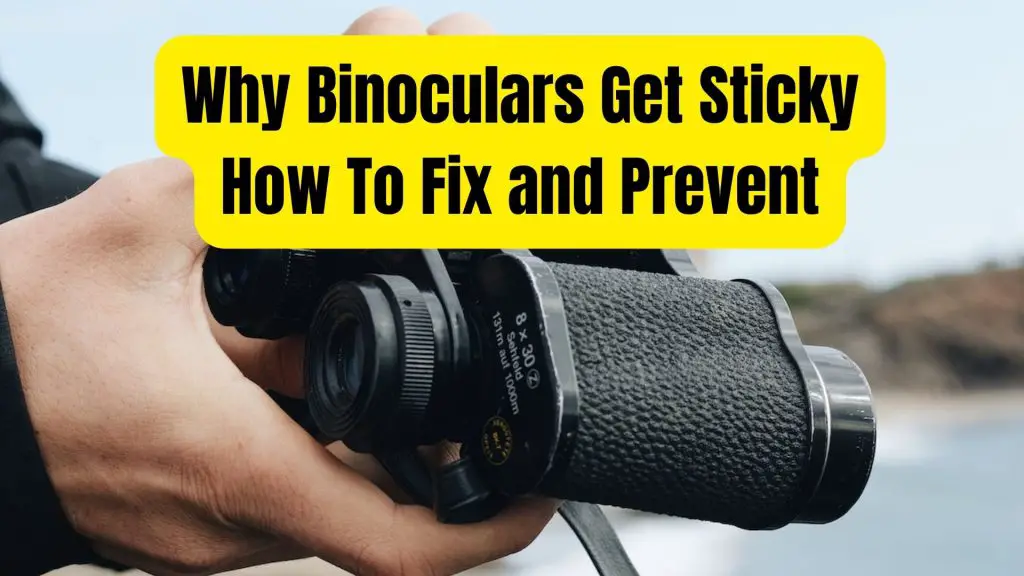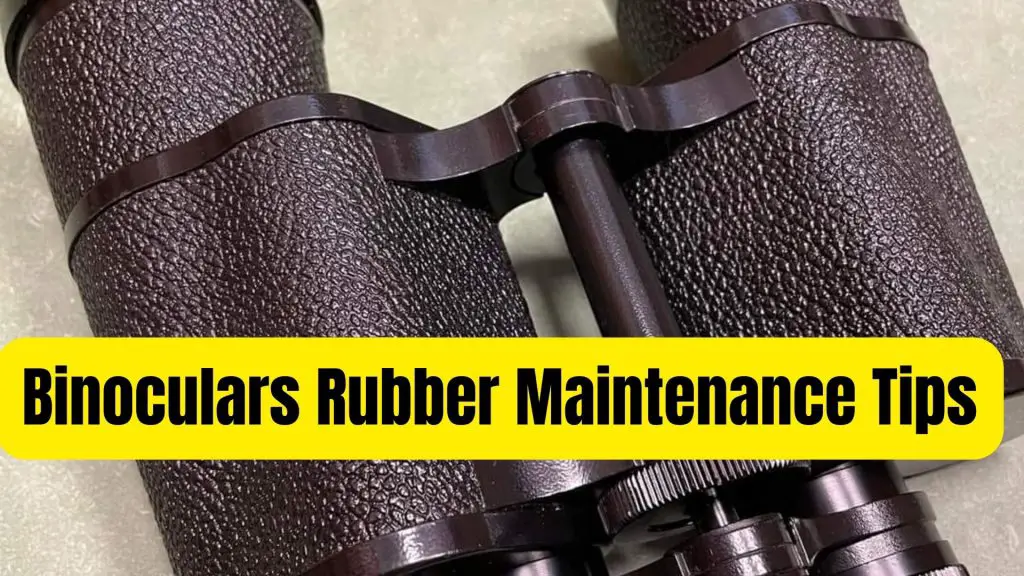Why Rubber On Binoculars Get Sticky: What Can You Do?

A common issue that many binocular owners face is the rubber coating on their binoculars becoming sticky over time.
This sticky rubber not only affects the appearance of the binoculars but also hampers their functionality.
Understanding the reasons behind this sticky rubber can help us find effective solutions to fix and prevent it.
Why Rubber-On Binoculars Get Sticky
The chemical breakdown of the rubber over time:
Rubber, like any other material, undergoes chemical changes over time.
The rubber used on binoculars is often a synthetic compound that contains additives to enhance its durability, flexibility, and resistance to environmental factors.
However, these additives can gradually break down due to aging and exposure to various elements.
As a result, the rubber becomes sticky and tacky to the touch. This breakdown is a natural process, but it can be accelerated by certain conditions.
Effects of environmental factors (heat, humidity, UV radiation):
Environmental factors play a significant role in the deterioration of rubber on binoculars.
Heat and humidity can cause the rubber to soften and become sticky, particularly if the binoculars are stored in a hot and humid environment for prolonged periods.
The combination of high temperatures and moisture accelerates the breakdown of the rubber compounds, leading to stickiness.
Similarly, exposure to ultraviolet (UV) radiation, such as direct sunlight, can cause the rubber to degrade more rapidly, resulting in a sticky texture.
Extensive Use Of Binoculars
Extended and improper usage of binoculars can contribute to the development of stickiness.
Consider a scenario where you use binoculars intensively for 8 to 10 hours a day without proper cleaning.
During such prolonged usage, sweat, oils from your hands, and environmental debris accumulate on the rubber surface.
Over time, these residues can contribute to the stickiness of the rubber coating.
Neglecting to clean the binoculars regularly further exacerbates the issue, allowing the buildup of dirt and grime to worsen the stickiness.
Low-quality rubber materials used in manufacturing:
In some cases, the rubber used on binoculars may be of inferior quality or not adequately formulated to withstand long-term use.
Manufacturers may choose lower-grade rubber materials to cut costs, compromising the overall durability and resistance to degradation.
As a result, the rubber coating on these binoculars can deteriorate more quickly and become sticky even with minimal exposure to environmental factors.
It is important to note that not all binoculars suffer from this issue, as many reputable brands prioritize using high-quality rubber materials.
Stickiness is a property of Rubber
The rubber used for the cover of binoculars is inherently sticky.
During the manufacturing process, known as vulcanization, the rubber undergoes a heating treatment that gives it a stretchy quality.
However, over time, the stretchiness diminishes, and the stickiness of the rubber becomes more pronounced.
This stickiness is a natural characteristic of the rubber material itself. The effects of vulcanization are not permanent and tend to fade after a few years, causing the rubber to become sticky again.
Negative consequences of sticky rubber on binoculars
The sticky rubber coating on binoculars can have several negative consequences that impact both the functionality and aesthetics of the instrument. Let’s delve into these consequences in more detail:
Decreased usability and grip:
The primary purpose of the rubber coating on binoculars is to provide a comfortable and secure grip.
When the rubber becomes sticky, it loses its non-slip properties and can make it challenging to hold the binoculars steadily.
This can be particularly problematic during outdoor activities or when observing objects for an extended period.
The decreased grip can lead to a higher risk of accidental drops, potentially causing damage to the binoculars or even resulting in the loss of a valuable tool.
Unpleasant sensation and appearance:
Sticky rubber on binoculars not only affects functionality but also creates an unpleasant tactile experience.
When you touch the sticky surface, it leaves residue on your fingers and can feel uncomfortable and slimy.
This sensation can be off-putting and distracting, diminishing the enjoyment of using the binoculars.
Moreover, the sticky rubber tends to attract dirt, dust, and other particles, making the binoculars appear unclean and unsightly.
Potential damage to the binoculars:
The stickiness of the rubber coating can have more severe consequences for the binoculars themselves. Over time, the sticky residue can attract and trap dirt, dust, and debris, creating a gritty surface.
This can potentially scratch the lenses or other delicate parts of the binoculars if not cleaned properly.
Additionally, the chemical breakdown of the rubber can result in its degradation, causing it to become brittle or even peel off in some cases.
Such damage compromises the overall integrity of the binoculars, leading to reduced performance and potentially rendering them unusable.
It is evident that the sticky rubber on binoculars poses significant drawbacks.
However, the good news is that there are effective ways to fix this issue and prevent it from occurring in the future.
In the next sections, we will explore various methods to address the stickiness of rubber on binoculars, as well as preventive measures to maintain the rubber coating in optimal condition.

How to fix sticky rubber on binoculars
If you’re dealing with sticky rubber on your binoculars, don’t despair!
There are several effective methods to restore the rubber’s original texture and eliminate unpleasant stickiness.
Let’s explore these techniques:
Cleaning methods: Remove Stickiness On Binoculars
Gentle soap and water solution:
- Start by preparing a solution of warm water and a mild liquid soap.
- Dampen a soft cloth or sponge with the solution and gently wipe the sticky rubber surface.
- Avoid using excessive force or abrasive materials that could damage the rubber.
- Rinse the cloth or sponge thoroughly and wipe away any soap residue. Finally, dry the binoculars with a clean, lint-free cloth.
Rubbing Alcohol or Isopropyl Alcohol:
Windex or Rubbing alcohol is an effective solvent that can dissolve sticky residues on rubber.
Moisten a cloth or cotton swab with rubbing alcohol and gently rub it over the sticky areas.
This method helps break down the stickiness and evaporates quickly, leaving the rubber clean and residue-free.
Ensure the alcohol doesn’t come into contact with any optical components or delicate parts of the binoculars.
You can also Use a toothbrush to get into those hard-to-reach crevices.
Magic Eraser
One effective solution to consider for sticky rubber is using a magic eraser pad. Here’s a simple step-by-step process to remove the stickiness:
- Take a magic eraser pad, which is a melamine foam cleaning tool readily available in stores.
- Dampen the magic eraser pad with water.
- Gently wipe the magic eraser over the sticky rubber surface, applying light pressure.
- Continue moving the magic eraser over the sticky area, making sure to cover the entire affected surface.
- Repeat the wiping motion until the stickiness is completely gone, and the rubber surface feels smooth and clean.
The magic eraser’s unique cleaning properties, combined with the gentle abrasiveness of the foam, can effectively lift and remove the sticky residue from the rubber.
However, it’s important to use caution and avoid excessive pressure to prevent any potential damage to delicate electronic components or sensitive surfaces.
Sticky tape or lint roller:
For smaller, hard-to-reach areas, sticky tape or a lint roller can be useful.
Wrap a small piece of tape around your finger or use a lint roller with adhesive sheets.
Press it against the sticky rubber surface and peel it off gently. The stickiness will adhere to the tape or roller, leaving the rubber clean.
Application of talcum powder or baby powder:
Talcum powder or baby powder can be effective in reducing stickiness on rubber surfaces.
Apply a small amount of powder onto a clean, dry cloth and gently rub it onto the sticky rubber. The powder helps absorb moisture and restore the rubber’s non-stick properties.
Remove any excess powder with a clean cloth.
Removing The Stickiness of Your Binoculars: An Interesting Video
Professional repair and restoration services:
If the stickiness persists or if you’re unsure about handling the issue yourself, it’s advisable to seek professional assistance.
There are specialized repair and restoration services available that can tackle the problem effectively.
These professionals have the knowledge and experience to assess the situation and employ appropriate techniques to restore the rubber coating to its original condition.
Remember, prevention is always better than a cure.
Taking proactive measures to protect your binoculars from stickiness can significantly reduce the likelihood of encountering this issue.
However, if you do face sticky rubber, the cleaning methods and mechanical techniques mentioned above, along with professional assistance when needed, can help revive your binoculars and ensure optimal performance for years to come.
Preventive measures to avoid sticky rubber on binoculars
By implementing some simple preventive measures, you can significantly reduce the chances of encountering sticky rubber issues. Let’s explore these measures:
Proper storage:
Avoiding exposure to heat and humidity:
Heat and humidity are primary culprits in the breakdown of rubber.
To prevent the rubber on your binoculars from becoming sticky, store them in a cool, dry place.
Avoid leaving them in areas prone to high temperatures, such as the glove compartment of a car or near radiators.
Similarly, keep them away from humid environments, such as bathrooms or basements.
Using protective cases or covers:
Invest in a good-quality protective case or cover for your binoculars.
These accessories provide an extra layer of protection, shielding the rubber coating from exposure to external elements.
When not in use, store your binoculars in the case or cover to minimize the impact of environmental factors.
Regular cleaning and maintenance:
Removing dirt, dust, and moisture:
Regular cleaning is essential to prevent the buildup of dirt, dust, and moisture on the rubber surface.
Use a soft brush or a microfiber cloth to gently remove any loose particles from the rubber.
Avoid using harsh chemicals or abrasive materials that can damage the rubber or strip away its protective coating.
Applying rubber protectants or conditioners:
Rubber protectants or conditioners can help maintain the rubber’s integrity and prevent stickiness.
Look for products specifically designed for rubber surfaces and apply them according to the manufacturer’s instructions.
These products create a protective barrier that shields the rubber from degradation caused by UV radiation and other environmental factors.
By implementing these preventive measures, you can extend the lifespan of the rubber coating on your binoculars and minimize the risk of encountering sticky rubber issues.
Conclusion
Prevention of sticky rubber on binoculars is crucial for optimal performance and longevity.
By storing your binoculars properly, away from heat and humidity, and utilizing protective cases or covers, you can shield the rubber from the elements.
Regular cleaning and the use of rubber protectants or conditioners will further enhance the rubber’s durability.
By following these preventive measures, you can enjoy clear vision and a comfortable grip while using your binoculars, ensuring many enjoyable outdoor adventures and observations ahead.
Also Read: How To Restore Old Binoculars
More Read: Can You Wear Contact Lenses While Using Binoculars
